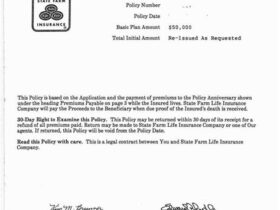Occupational accident insurance is a critical component of workplace safety and employee well-being in the United States. It provides financial protection to employees who suffer injuries or illnesses as a direct result of their job. This guide aims to provide a comprehensive overview of occupational accident insurance, outlining its benefits, coverage, and importance for both employers and employees. Understanding this type of insurance is crucial for creating a safer and more secure work environment.
What is Occupational Accident Insurance?
Occupational accident insurance, often referred to as work accident insurance, is a type of insurance policy that provides benefits to employees who sustain injuries or illnesses while performing their job duties. Unlike workers’ compensation, which is mandated by law in most states, occupational accident insurance is often an optional coverage that employers can provide to supplement or, in some cases, act as an alternative to traditional workers’ compensation.
The primary purpose of occupational accident insurance is to offer financial assistance to employees to cover medical expenses, lost wages, and other related costs resulting from a work-related accident. This can be especially important for businesses that operate in industries with higher risks of workplace accidents, such as construction, manufacturing, and transportation.
Benefits of Occupational Accident Insurance
Offering occupational accident insurance brings several key benefits for both employers and employees. These include:
- Financial Security for Employees: If an employee is injured on the job, occupational accident insurance can help cover medical bills, rehabilitation costs, and lost income during their recovery period. This financial safety net can alleviate stress and allow employees to focus on healing without the added burden of financial worries.
- Attracting and Retaining Talent: Providing a comprehensive benefits package, including occupational accident insurance, can make a company more attractive to potential employees. It demonstrates a commitment to employee well-being and can improve employee morale and loyalty, ultimately leading to higher retention rates.
- Potential Cost Savings: In certain circumstances, occupational accident insurance may offer cost savings compared to traditional workers’ compensation, especially for companies with a high frequency of claims. However, it’s essential to carefully evaluate the coverage and limitations of the policy to ensure it meets the needs of both the employer and the employees.
- Peace of Mind: Knowing that they are protected in case of a work-related accident can significantly reduce stress for employees and employers alike. This peace of mind can improve productivity and create a more positive work environment.
- Reduced Legal Risks: While occupational accident insurance is not a substitute for workers’ compensation in states where it is required, it can help mitigate legal risks by demonstrating a proactive approach to employee safety and well-being.
Coverage Details

Occupational accident insurance policies typically cover a range of expenses associated with work-related injuries and illnesses. The specific coverage details can vary depending on the policy and insurance provider, but common benefits include:
- Medical Expenses: Coverage for doctor visits, hospital stays, surgeries, prescription medications, and other medical treatments necessary for recovery.
- Temporary Disability Benefits: Payments to help replace lost wages during the period when an employee is temporarily unable to work due to their injury.
- Permanent Disability Benefits: Compensation for employees who suffer a permanent disability as a result of a work-related accident, such as the loss of a limb or vision.
- Accidental Death Benefits: Payments to the employee’s beneficiaries in the event of a fatal work-related accident.
- Rehabilitation Services: Coverage for physical therapy, occupational therapy, and other rehabilitation services to help employees regain their functional abilities.
- Vocational Retraining: Assistance with job training and placement services for employees who are unable to return to their previous job due to their injury.
Reporting an Accident and Filing a Claim

In the event of a workplace accident, it’s crucial to follow proper procedures for reporting the incident and filing a claim for occupational accident insurance benefits. Here are the general steps involved:
- Report the Accident: Immediately report the accident to your supervisor or employer, providing as much detail as possible about the incident, including the date, time, location, and nature of the injury.
- Seek Medical Attention: Obtain prompt medical attention for your injury. Be sure to inform your healthcare provider that the injury is work-related and provide them with the necessary information for billing and documentation purposes.
- Document the Accident: Take photos of the accident scene, your injury, and any equipment or materials involved. Gather contact information from any witnesses to the accident.
- File a Claim: Obtain a claim form from your employer or the insurance provider and complete it accurately and thoroughly. Include all relevant information, such as the date of the accident, a description of the injury, and the names of any witnesses.
- Submit the Claim: Submit the completed claim form along with any supporting documentation, such as medical records and witness statements, to the insurance provider.
The Importance of Workplace Safety

While occupational accident insurance provides financial protection after an accident occurs, it’s equally important to prioritize workplace safety to prevent accidents from happening in the first place. Employers have a responsibility to create a safe work environment for their employees by implementing safety programs, providing adequate training, and enforcing safety regulations.
Some essential workplace safety measures include:
- Conducting regular safety inspections to identify and address potential hazards.
- Providing employees with proper training on safe work practices and the use of equipment.
- Ensuring that all equipment is properly maintained and in good working condition.
- Providing employees with appropriate personal protective equipment (PPE), such as hard hats, safety glasses, and gloves.
- Establishing clear safety policies and procedures and enforcing them consistently.
By prioritizing workplace safety, employers can reduce the risk of accidents and injuries, protect their employees, and create a more productive and positive work environment.
In conclusion, occupational accident insurance is a valuable tool for protecting employees and employers from the financial consequences of workplace accidents. By understanding the benefits, coverage details, and claims process, both parties can ensure they are adequately protected in the event of an injury. However, it’s important to remember that prevention is always the best approach, and prioritizing workplace safety is essential for creating a secure and healthy work environment for everyone.





Leave a Reply